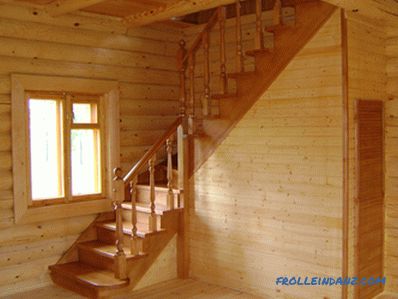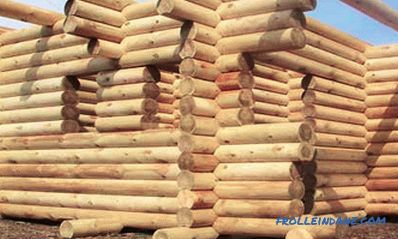Often the household uses an electric appliance such as a drill. Every owner knows how reliable an assistant this power tool is. In the necessary places, he easily drills holes of different diameters. This is only possible thanks to drills. During operation, the drill may need sharpening. Some decide to simply replace them by buying new ones. But in most cases, the old drill can be brought back to life. In this article we will explain how to properly sharpen the drill. Consider the differences sharpening drills for wood, metal and concrete.
What is needed for sharpening the drill at home
It does not matter for what materials the drill is used, you must prepare the following tool and material in advance:
- Safety glasses.
- Water tank.
- Drill.
- Grinding wheel or sharpening machine.
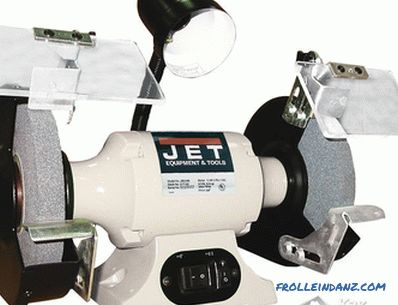 Sharpening machine
Sharpening machine
In most cases, drill bits up to Ø16 mm are used at home. Therefore, special difficulties when sharpening such drills you should not. Most importantly, understand the principle of this process.
Sharpening a spiral type drill
As for wood drills, they should be sharpened extremely rarely. This can not be said about the drill metal. Such a drill should always be sharp. How do I know if a drill needs sharpening? At the beginning of drilling, it emits a characteristic creak. Worn drill quickly heats the product, respectively, more erased. As a rule, the drills sharpen on special machines, at home, you can use a small grinding machine with a stone. So, how to properly sharpen the drill bit for metal? The method and type of sharpening will directly depend on the required shape of the back surface of the drill. For example, it may be:
- Single Plane.
- Two-plane.
- Conic.
- Cylindrical.
- Screw.
 Spiral drill
Spiral drill
In any case, the sharpening of the drill is performed on the back face. Two teeth sharpen the same. If you decide to do it manually, it will be quite inconvenient. Moreover, it will be extremely difficult to manually maintain the desired shape of the back face and the angle.
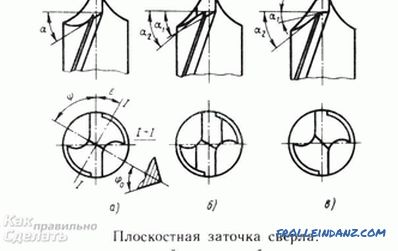 Planar sharpening of a drill
Planar sharpening of a drill
Single-plane sharpening is characterized like this because the back of the pen has one plane. Rear angle has an average of 28-30 °. When sharpening, the drill must be attached to the circle so that its cutting part runs parallel to the circle. At the same time the drill can not be rotated and moved. This method of manual sharpening has one drawback; the cutting edge of the drill is chipped out. But at the same time for the drill Ø3 mm is the easiest method of manual sharpening.
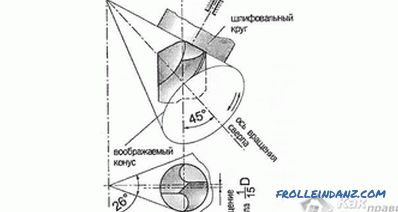 Conical method
Conical method
If you want to sharpen the drill more than Ø3 mm, then choose a conical method. Although it is difficult to grind by this method, it is possible. The right hand should take the drill by the tail, and the left by the working part is closer to the intake cone. The drill is pressed to the end face of the grinding stone with a cutting edge and a rear surface. With your right hand you need to shake slightly, thereby forming a conical surface on the edges. Hand movements should be smooth and slow, hands should not be torn off from the stone. To sharpen the second pen, the procedure is repeated.
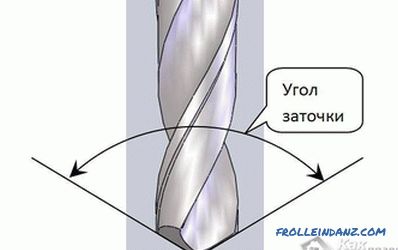 Sharpening angle chart of a drill
Sharpening angle chart of a drill
During the sharpening process, it is desirable to keep the factory shape of the drill back of it parts, this will save the desired rear angle.
What is the purpose of such a point? The life of the drill increases by reducing the rake angle, and the angle of the cutting edge increases, respectively, all this increases the resistance of the drill to chipping. The width of the transverse edge will automatically become smaller. This edge does not drill metal, but only scrapes it in the central part. If possible, you can fine-tune the drill. By this process is meant the removal of chipping after sharpening. So, drills will serve much longer. For this process, you can use grinding stones made of silicon carbide green on a bakelite bond with a hardness of M3-CM1, with a grain size of 5-6, a 63C grade of stone. In addition, you can take the grinding wheel from elbor LO on a bakelite bunch with a grain size of 6-8.
How the victor drill
 is sharpened Pointed victor drill
is sharpened Pointed victor drill
As a rule, victor Concrete drill bit used. It may also need sharpening. During the drilling process, the blunt drill will become very hot, and, accordingly, may produce a characteristic screaming sound. If you want to save on buying a new one, then you can try to sharpen the drill yourself. It is enough to prepare for this:
- Sharpening machine with a diamond wheel.
- Coolant.
If the soldering on the cutting part of the drill has a height of 10 mm, then you can sharpen the drill bit.
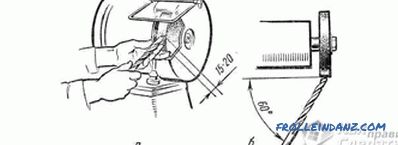 The sharpening pattern of the poorest drill
The sharpening pattern of the poorest drill
It is important to take into account one known fact than the harder material, the lower should be the speed of sharpening. On a poker drill, you only need to correct the loosened edges, so its sharpening will be fast. In the process it is important not to rush, otherwise there is a risk of lick the excess surface of the drill. Sharpen the front surface of the drill. In the case when the soldering is already stochna to the base of the drill, you will need a point. To the thickness of the center of soldering was less, at the same time it is necessary to undermine the front surface. After sharpening, both cutting sides must be the same size, otherwise the holes will be uneven and enlarged. In the process of sharpening pobedit drill it is important to maintain an angle of 170 °, this is especially necessary if the material is sufficiently hard.
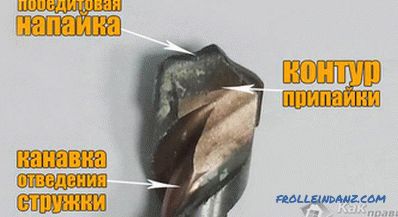 Pobeditovoe drill
Pobeditovoe drill
It is not allowed to overheat the drill during sharpening. Carbide inserts may peel off on it and the surface may crack. Therefore, the process should occasionally cool the drill in water or oil.
So, we considered the basic principles of sharpening drills for wood, concrete and metal. You can share your comments!
Video
By watching the following videos, you will learn how to sharpen twist drills. This four-part video tutorial details the sharpening technology.
Processing the back surface of the drill:
Stitching the drill jumper:
Sharpening technology for small-diameter drills , carbide drills and others:

